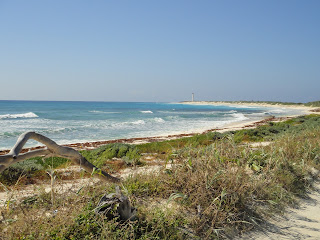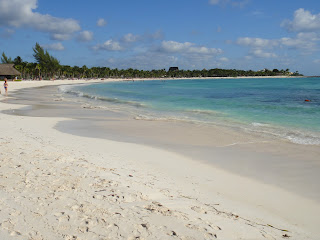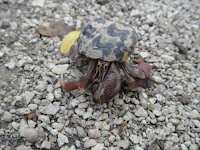This weekend the weather was great again (starting to feel like spring - the sunshine is stronger and the mornings are not that cold any more), so we spent the weekend outdoors, in Park Chapultepec. It`s not so far from our home, by bus it is about half an hour. (It is better to take the bus, because parking is impossible in the weekends.) The park itself is huge, with museums (the biggest of it is the Anthropology Museum), a big lake, the zoo, a castle and of course, many many green.
 This time we had 3 goals:
This time we had 3 goals:1) To see if squirrels in Mexico go into hibernation or not. => The answer is NO. They were jumping around in the middle of January just as always.
2) To go to the zoo and finally see all its parts. (This was the 3rd time to go there and finally we could walk around all of it.)
3) To see the Chapultepec Castle - for that I need to explain a little bit of Mexico`s history, as there is a historical exhibition in the castle.
The exhibition is because (to my big surprise) it was the home of Maximilian from the Habsburg Monarchy. I was surprised, because - as it turns out - this Maximilian was the younger brother of Franz Joseph, emperor of the Austro-Hungarian Monarchy. But how did this Austrian Maximilian to Mexico? For that let me start from a little bit earlier...
The Spanish rule in Mexico lasted until the 18th century, when the Bourbon dynasty started to fall - problems between Spain and the Mexican colony started to surface, and the more and more aggressive centralization, the raise of taxes led to rebellions by the 19th century. The first rebellion for independence started by Miguel Hidalgo in 1810. It was repressed, but by 1821 Spain was forced to acknowledge the independence of Mexico.
However, by gaining independence, Mexico lost the Spanish capital. In the midst of the uncertainty and decadency of the 19th century, the country was not only divided by the monarchists and republicans, but also went to war on the north as well. (It was around 1840 when Mexico lost its northern territories (Texas etc) and today`s Mexico has evolved.) In the 1850`s a relatively peaceful period seemed to evolve by the election of Benito Juarez. However, as Juarez wanted to focus the money on nourishing the country, he announced moratorium for paying off of the overseas` debts. Of course, the foreign governments didn`t like this idea, especially France. Therefore, Napoleon III took intervention and attacked the country.
In this period of intervention was Maximilian asked for the throne by the Mexican royalists. He accepted it, disclaimed his right for the Austrian throne (in case something happened to Franz Joseph) and headed to Mexico in 1864. Maximilian unfortunately knew nothing of his country, he believed that the waving mass that greeted him in Veracruz (where his ship arrived) represented the whole country. However, a big part of the nation was against him and took the republican Juarez`s side. The number of Juarez`s people have grown as the french army (on the name of Maximilian - although he did know nothing about it) did more and more violence on the Mexican people. As the North-American war ended in 1865, the rebellion against the empire had grown. By 1867, Maximilian was deposed from Mexico City to Queretaro, and shortly after was captured by the republicans. Juarez, who got back his previous position after the rebellion, sentenced Maximilian to death. That`s how the short (3 years and 70 days) regime of the Habsburgs ended in Mexico...
And in these 3 years, Maximilian and his wife lived in the Castle of Chapultepec. The exhibition shows the era of this period - from the independence rebellions until the era of Juarez and his successor, Porfirio Diaz. The castle was not built for Maximilian, it had been here long before as the summer residence of the Aztecan emperors. Today`s style, however, is totally European - the furniture in the rooms, the stucco on the ceiling, the parquet on the floors, the mosaics on the walls... As the building was built on a small hill, the view is beautiful to the park and to the city. Paseo de la Reforma - which Maximilian ordered to build in order to access to the city center - can be well seen from here as well. The castle is beautiful both inside and outside: outdoors you can enjoy the fountains, carefully cultivated garden and the huge terraces with beautiful views. In the inside, not only the exhibition is interesting, but the halls are worth to take a look at as well. Unfortunately, the explanations are only in Spanish, but the paintings, the contemporary rooms and clothes doesn`t need much explanation.
 |
| Office of Maximilian |
After going around in the castle, we strolled down to the zoo, to finally "capture it". It took for us three (!) times to finally walk around every part of it. This zoo is not only huge, but the entrance is free! (It`s the best idea one can have!)
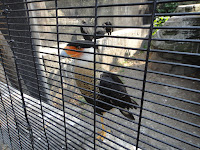 |
| Caracara |
The bird section was amazing, with many many birds - here, they are in huge cages, and not only one species in one cage, but many mixed together. So, it was fun to search for them and identify which one is which. Of course, most of the birds are from the American continent, which was very interesting for us, as most of them we haven`t even heard of. One of these "exotic" birds was the Caracara, a smaller carnivore, which is Mexico`s national bird as well. It was very nice with its yellow-white head and also was good to see how curious it is - as many people gathered around, it came forward and walked around us. It was hard to decide, who`s behind the cage: the bird or us...
 |
| The Mexican hairless dog - Xoloitzcuintli |
We had to recognize again that this park is so huge, that one can spend 2-3 days without getting bored.
(For more pictures, just click on the main title!)
 |
| In front of the castle |
A hétvégén a szép idő megint kicsalt minket a lakásból - ezen a hétvégén Mexikóváros "Városligetébe", a Chapultepec parkba mentünk. A park hatalmas mérete igazodik Mexikóváros méreteihez: a parkban található az Antropológiai Múzeum (hogy csak a legnagyobbat emlitsem), az állatkert, egy vár, csónakázótó és persze rengeteg zöld.
Ez alkalommal három tervünk volt:
1) Megnézni, hogy a mexikói mókusok is téli álmot alszanak-e.
Erre a válasz NEM. A mókusok úgy szaladgáltak január közepén is, mint bármikor. Hát igen, ezt teszi az egész éves jó idő.
2) Elmenni az állatkertbe, és végre (harmadszorra) bejárni az egészet.
Ez végre sikerült, az utolsó, még nem látott részt (a madarakat) is láttuk.
3) Felmenni a Chapultepec várba.
És itt jön egy kis történelem óra - a vár ugyanis (csakúgy, mint a Budai Vár) egy történelmi kiállitást foglal magába, ami miatt újra elő kellett vennem Wikit egy kis történelem lecke gyanánt.
Nagy meglepetésre ugyanis, Chapultepec vára Habsburg Miksa mexikói császár lakhelye volt! Ha Habsburg, akkor ugye Oszrák-Magyar Monarchia. Nos, mint kiderült ez a mi Miksánk épp Ferenc József testvére volt, vagyis a 19. századba kell besorolnunk. No, de hogy jön Mexikóhoz? Ehhez egy kicsit vissza kell lapozni a történelemkönyvben, hogy megérthessük a dolgokat.
A spanyol hóditás a 16. századtól töretlen volt a 18. századig, amikor is a Bourbon dinasztia kezdett megingani - az anyaország és Mexikó közötti kapcsolat romlása, az egyre nagyobb centralizáció, növekvő adók és az őslakosság elnyomása a 19. század elejére felkelésekhez vezetett. 1810-ben Miguel Hidalgo (egy plébános) inditotta a függetlenségi felkelést a spanyol hóditás ellen (ezt leverték a spanyolok), de a harcok folytatása után végül 1821-ben kinyilvánitották Mexikó önállóságát. Az önállóság megszerzésével azonban a spanyol tőkét elvesztette az ország, igy az egyre nagyobb bizonytalanság és romlás közepette a 19. század elég viharosnak bizonyult. Nemcsak a konzervativ, monarchisták és a liberális köztársaságpártiak között folyt a vita, Mexikó háborúba keveredett Amerikával is (az 1840-es években, amikor is Mexikó elvesztette Texast és az északi tartományait, kialakitva a jelenlegi országképet). Egy rövid békeidőszak látszott elkezdődni Benito Juarez, egy indián származású ügyvéd köztársasági elnökké választásával (1854). Juarez az ország talpra állitása érdekében azonban a külföldi adósságok kifizetését elhalasztotta, amiért is megorrolt rá III. Napóleon és intervenciót hajott végre. III. Napóleon és a franciák Mexikóban tartózkodásakor hivták meg a rojalisták Habsburg Miksát a mexikói trónra, aki kis huza-vona után, el is fogadta a trónt. 1864 áprilisában indult útnak és májusban kötött ki Veracruzban. Miksa sajnos semmit nem tudott az ország politikájáról, ezért naivan elhitte, hogy a körülötte tomboló tömeg az egész országot szimbolizálja. (Pedig a mexikóiak nagy része a megbuktatott Juarez pártján állt.) Sajnálatos módon nem vette észre azt sem, hogy a franciák a császár megbizására hivatkozva öldösik és kifosztják a népet, amit az persze nem tűrt sokáig. 1865-ben, az észak-amerikai háború befejeztével, az amerikaiak is csatlakoztak a mexikói köztársaság-pártiakhoz (ugyanis féltek a franciák további nyomulásától). 1867-re Habsburg Miksát a köztársaság-pártiak Queretaroba száműzték, ahol végül elfogták és az újra megválasztott Benito Juarez (hogy példát mutasson) Habsburg Miksát halálra itélte. Igy ért véget a Habsburg uralom rövid, három éve Mexikóban...
Ez alatt a három év alatt Miksa és felesége a Chapultepec-i várban lakott, ezeket az időket örökiti meg a vár kiállitása. A vár egyébként nem Habsburg Miksának épült, állitólag az azték császárok nyaralóhelyének épitették. A mai formája azonban európai stilust tükröznek a bútorok, a cirádás stukkók, mozaikok és mintás parketta. A várba gyalog és kisvonattal is fel lehet menni, mi felfelé menet ezt választottuk. Mivel egy kis dombon áll az épület, gyönyörű a kilátás az egész parkra, és a városra. Jó kilátás nyilik a Paseo de la Reformára is, amit szintén a mi Miksánk épittetett. A vár kivül-belül gyönyörű: kint szép szökőkutak, hatalmas terasz és gondosan ápolt kert várja a sétálni vágyókat. Bent (mint már emlitettem) a szabadságharctól kezdve, Habsburg Miksa és az őt követő Juarez és Porfirio Diaz időszakáig láthatunk kiállitást. Nemcsak a termek lélegzetelállitóak, de a kiállitási tárgyak is nagyon érdekesek voltak - korabeli ruhák, ékszerek, csészék stb. És persze rengeteg festmény, kép és korabeli iratok. Sajnos, a magyarázatok csak spanyolul volt kiirva. A vár egyik részében még Miksa hintói is ki vannak állitva, egy másikban pedig a császár szobáit renoválták - nehéz brokátok, aprólékos szőttesek, mahagóni és persze ezüst, ezüst, ezüst!
 |
| The chariot of Maximilian |
A vár után lesétáltunk az állatkertbe, hogy végre körbejárjuk egészen. Most az északi részt néztük meg, a jegesmedvéket és madarakat. A hőség miatt a jegesmaci nem nagyon mozgott, de örömmel láttuk, hogy itt is a medvék, fókák és pingvinek része úgy van kialakitva, hogy alulról is meg lehet közeliteni, igy látni, ha az állatok a vizben lubickolnak. (Amikor mi voltunk, csak a fóka úszkált - volt is hatalmas tömeg körülötte!) A madarak már érdekesebb volt, hatalmas ketrecekben vannak, és több madár együtt, igy igazán élvezet nézni, keresgélni őket. Persze, itt is az amerikai földrész madarai voltak többségben (legtöbbjükről még hallani sem hallottam): köztük volt a Caracara is, egy kis termetű ragadozómadár, ami ráadásul Mexikó nemzeti madara. Volt egy "madárröpde" is, ahova be lehett menni a madarak közé - bár legtöbbjük kacsa és vadlúd volt, volt pár egzotikus madár is, mint például a pelikán. Két pelikán ott ült a bejárat előtt, "köszönteni minket". Persze, ha valaki közel ment, csattogtattak a hatalmas csőrükkel, ami bizony elég volt arra, hogy elriassza az embert.
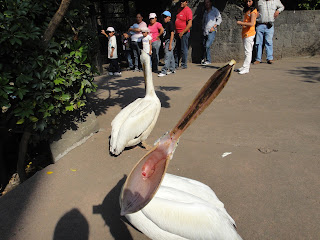 |
| Angry pelican tries to bite us |
Ismét rá kellett jönnünk, hogy Chapultepecben az ember nyugodtan el tud tölteni 2-3 napot úgy, hogy nem unatkozik - hiszen ott van az Antropológiai Múzeum, az állatkert, a vár... ezekhez mind legalább fél nap (ha nem egy egész kell) bejárni.
(További képekért kattints a főcimre!)



























